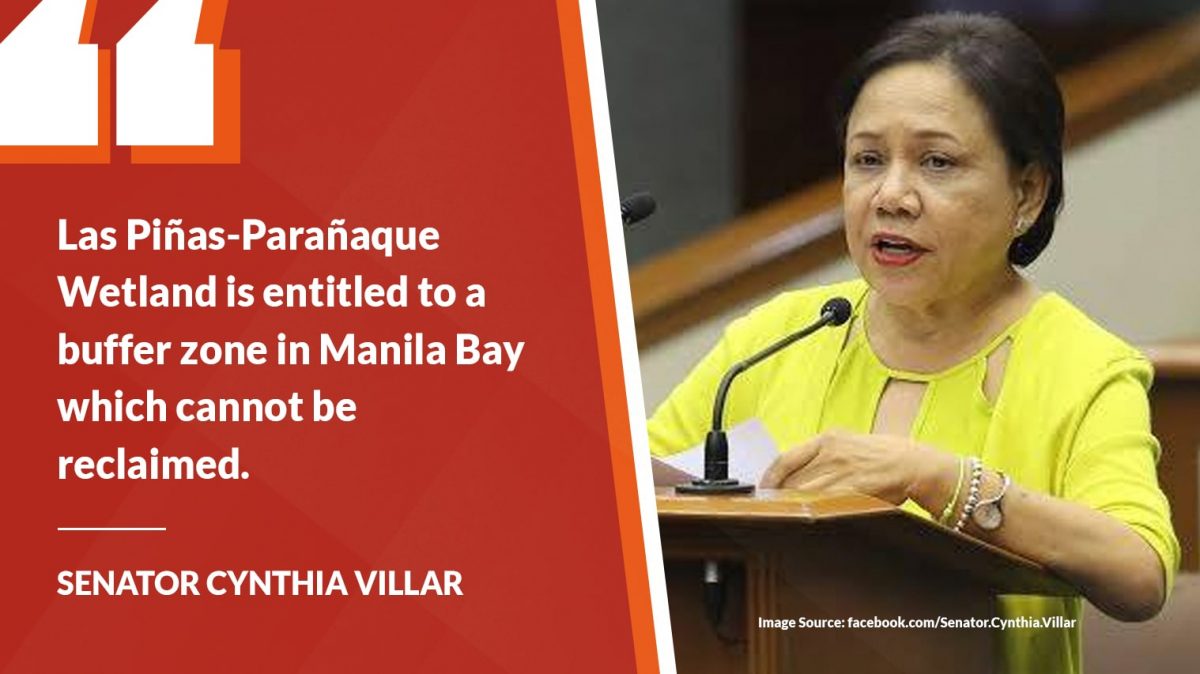Senator Cynthia Villar will file a Motion for Reconsideration (MR) before the Supreme Court (SC) over its “go-signal” to reclaim the Manila Bay areas In Las Pinas and Paranaque as she urged the High Court to take a “different and fresh appreciation” of the environmental impact assessment (EIA) rules.
Villar has been asserting that any reclamation project in the areas would impede the flow of the six (6) rivers exiting in Manila Bay, which would cause massive flooding, namely:
1. Imus River in Imus City,
2. Bacoor River in Bacoor City
3. Molino River in Bacoor City
4. Zapote River between Bacoor and Las Piñas cities
5. Las Pinas River in Las Piñas City
6.Parañaque River in Paranaque City.
In fact, the damage in Imus River caused the filing of a case by Atty. Antonio Oposa, a Ramon Magsaysay Awardee for Environmental Law, which resulted in the issuance of Mandamus of Manila Bay by the Supreme Court.
As we mark the first year of the UN Decade for Ecological Restoration, the veteran legislator called on the court magistrates to revisit its ruling which favored Alltech Contractors proposed projects to develop hectares of land in Las Piñas and Parañaque, both along the coastline of Manila Bay, which has been given up and declared illegal and the ECC has expired.
“This and the Declaration by Congress of the existence of a Climate Crisis, and the two reports of the Nobel-Laureate group Intergovernmental Panel on Climate Change, have long since rendered any decisions of the DENR made in 2012 irrelevant,” the seasoned lawmaker stressed.
With due respect, the lady lawmaker said the SC can also take judicial notice of the Expanded National Integrated Protected Areas System (E NIPAS) Act or RA 11038 which was passed in 2018.
“This legislated the now renamed Las Piñas Parañaque Wetland Park (formerly LPPCHEA) into a protected area. The legislated protected area, Las Piñas-Parañaque Wetland is entitled to a buffer zone in Manila Bay which cannot be reclaimed,” she said, noting that this was included in the Ramsar Convention list of Wetlands of International Importance, in 2013.
Villar related that the DENR is also determining the extent of the buffer zone needed for the conservation of the protected wetland park.
“The DENR’s procedures on EIA should take into consideration all these 94 newly established Protected Areas.”
“The DENR’s procedures on EIA should take into consideration all these 94 newly established Protected Areas (PAs),” said the chairperson of the Senate Environmental committee.
“We have long imagined that the ecological services like the flood drainage mechanisms and the filtering capacity of the soil will be there forever. But without proper care, and paying the costs of that care, these services will dissipate. The EIA system must account for this degeneration,” Villar added.
The SC recently affirmed a Court of Appeals (CA) decision denying the petition for a Writ of Kalikasan filed by Villar and 315,000 petitioners to stop a reclamation that is beside the said internationally important wetland.
According to her, the SC issued the decision eight years after the CA junked her petition to stop any reclamation project in the area.
“The DENR’s decision to allow the reclamation has long since been overtaken by multiple studies.”
Villar likewise emphasized the DENR’s decision to allow the reclamation has long since been overtaken by multiple studies, many scientific and valuation findings, most of which were not in the case file.
“Worse, any environmental decision taken in an application for an Environmental Compliance Certificate (ECC) only has a 5-year validity, considering the changes in the surrounding environment and new scientific findings that may happen,” she explained.
Villar also pointed out that the ECC of Alltech, despite this SC Decision, has long since expired, and the failure to start up the project was not caused by this case.
She also said if the Supreme Court says the DENR currently has sufficient technical capacity to make a determination in this case of all the factors that need to be taken into account, then why is our environment still on the decline.


